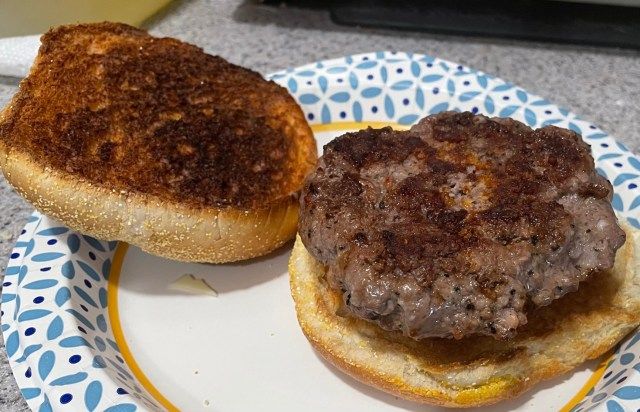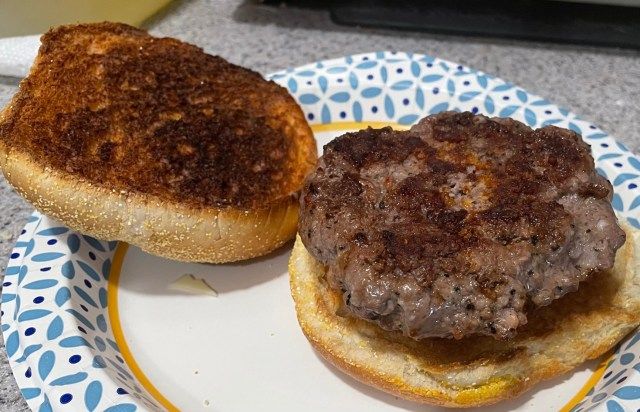Hamburger Experiment

Recipe:
http://www.myculinaryblog.com/index.php/2021/02/03/steak-burger-recipe/
Work-In-Progress (Original Artcle written 1/31/21) (Updated 2/3/21)
I’ve been trying to figure out the best hamburger recipe and think I’ve made some progress. The common problems I’ve encountered with burgers are as follows:
1. They don’t hold together well. When turning them in the grill or on the stovetop, they start to crumble and fall apart. All of the professional cooks say not to handle the burgers too much. It sort of seems like a contradiction. The burgers needs to be formed enough to stay together but not too tightly packed. I know some people say to use egg or some other binder but I don’t want my burger to be like a meatloaf.
2. They are sometimes dry and tasteless.
3. They turn out looking like hockey pucks.
All of these problems seem to have the same solution (adding more fat and variations of meat). I’ve looked through lots of blogs, Youtube videos, and have read many books on the subject of making the best burger. It seems that there are possibly 5 cuts of meat that are commonly used in burgers.
A. Chuck
B. Sirloin
C. Brisket
D. Short Rib
E. Top Round
F. Flank/Skirt
G. Ribeye
I’m sure there are others too.
It is debatable on the fat content that is best. Some people say 85/15 while others say 80/20 and 70/30. If you are looking to make a simple burger (not mixing various cuts of meat), it seems as though Chuck is the most common. This has the correct amount of fat. If you want to get a little more adventurous, you can mix Sirloin and Chuck together (50/50 mix of the two).
The opinions vary on the subject but the idea is that Chuck is at the sweet spot for fat content but Sirloin is said to have a better flavor. Regardless of whether you use straight Chuck or go with a mixture of different fats, it is best to stay around the 80/20 mark.
Whether it is Chuck, Sirloin, or Chuck/Sirloin mixture, I still haven’t been happy with the taste and texture of the burger.
For this reason, I decided that I wanted to try some other meat mixtures.
At the store today, I bought beef short ribs, Sirloin, Chuck, and some Bacon. I wanted to buy Brisket but this is difficult to get in small sizes.
The Sirlion and Chuck was already ground but I needed to finely cut up the short ribs and Bacon.
Out of the 1.5 pound container of short ribs, there was about 6 ounces of useable meat. The rest was fat, bone, and other cartilage. I wanted meat that had some marbling but not anything that would be un-chewable. The waste will be used later for a beef broth or stock.
Since I had 6 ounces of short rib meat, I decided to use the same amount for the Chuck and Sirloin. Altogether, I had 18 ounces of meat (6 ounces of each cut).
I added 3 ounces of bacon. I didn’t want the bacon to be too overpowering but the slight salty/smokiness would be good.
After chopping the short ribs and bacon, it was mixed with the the Sirloin/Chuck.

I formed these into 6 ounce patties and cooked them in frying pan on stovetop.


There was a lot of grease (I’m assuming mostly because of the bacon) but the flavor of the meat was excellent. I agree that it might not be the most visually appealing yet. I would like to get the burgers browned a little more and also have the shape a little flatter. I want to try this on a grill but might have to watch for flare-ups due to the excess grease.

Based on the original problem I was trying to solve. I think 1 and 2 are fixed (patties staying together and flavorful).
It was either the different textures of meat and/or the fat content that held the meat together better.
The flavor was definitely improved with the addition of the bacon and short ribs.
Latest Update (2/3/20)
I made some variations for the second time of doing this. Based on my first experiment, I thought that the burgers tasted really good but they were a little too greasy and were still like hockey pucks. Here are the changes I made.
Out of 1 Pound of Meat, here are the ratios I used
6 Ounces of Sirloin (Assuming 90/10 ratio). This is 37.5 % of the total weight
6 Ounces of Chuck (Assuming 80/10 ratio). This is 37.5% of the total weight
2 Ounces of Bacon (Assuming 60/40 Ratio). This is 12.5% of the total weight
2 Ounces of Short Rib (Assuming 70/30 Ratio). This is 12.5% of the total weight.
This mixture puts me at roughly 80/20 meat to fat ratio.
Another change I made was adjusting the thickness of the patties. I made 6 ounce patties. I originally made these a little thicker but this still left me with a hockey puck consistency when cooked. This time, I flattened out the patties even more. I made the diameter a little wider than the hamburger bun (assuming a little shrinkage). When I did this, I didn’t have the indentation in the burger. They came out to a perfect size.
With these modifications, there was less grease. Also, the potential for overcooking the burger is greatly reduced due to the juiciness (as compared to a using a higher meat to fat ratio like only Sirloin).
The two changes I would make for next time would be to cut the Bacon and Short Ribs into smaller sizes (maybe use a food processor or meat grinder). Some parts of the burger were a little stringy due to the fact that I could not chop the meat fine enough using just a chef’s knife.
If I get a meat grinder, I may also freeze the Short Rib and Bacon ahead of time so it doesn’t rip in the machine. I’d like to hold it’s form and not rip or shred as it goes through the grinder. A lot of chef’s have recommended this.
I will post a final recipe shortly.
